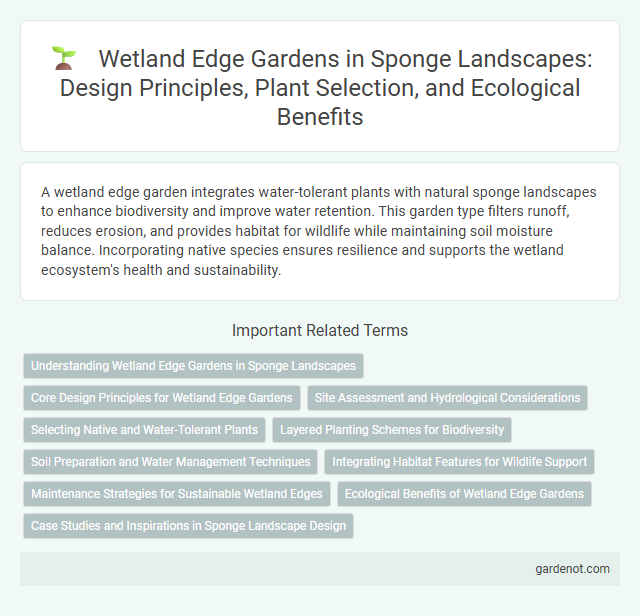A wetland edge garden integrates water-tolerant plants with natural sponge landscapes to enhance biodiversity and improve water retention. This garden type filters runoff, reduces erosion, and provides habitat for wildlife while maintaining soil moisture balance. Incorporating native species ensures resilience and supports the wetland ecosystem's health and sustainability.
Understanding Wetland Edge Gardens in Sponge Landscapes
Wetland edge gardens serve as crucial transitional zones in sponge landscapes, enhancing water filtration and habitat diversity by supporting native wetland vegetation adapted to fluctuating moisture levels. These gardens stabilize soil erosion along water margins, manage stormwater runoff effectively, and promote groundwater recharge by facilitating natural water absorption. Integrating wetland edge gardens strengthens the ecological resilience of sponge landscapes, balancing urban development with sustainable water management.
Core Design Principles for Wetland Edge Gardens
Wetland edge gardens require careful attention to hydrology, soil type, and native plant selection to enhance biodiversity and water filtration. Incorporating multilayered vegetation buffers stabilizes shorelines, reduces erosion, and provides habitat for wetland wildlife. Effective design also prioritizes water flow management to maintain wetland health while supporting pollinators and aquatic species.
Site Assessment and Hydrological Considerations
Site assessment for wetland edge gardens involves detailed analysis of soil type, topography, and existing vegetation to ensure optimal plant selection and placement. Hydrological considerations include monitoring water table fluctuations, surface runoff patterns, and seasonal flooding to maintain soil moisture balance and support wetland biodiversity. Integrating native wetland species and natural water filtration processes enhances ecological function and resilience against erosion.
Selecting Native and Water-Tolerant Plants
Choosing native and water-tolerant plants for a wetland edge garden enhances ecosystem stability and supports local wildlife habitats. Species such as pickerelweed, blue flag iris, and willows naturally thrive in saturated soils, improving water filtration and reducing erosion. Integrating these plants promotes biodiversity while maintaining the sponge landscape's capacity to manage stormwater effectively.
Layered Planting Schemes for Biodiversity
Layered planting schemes in wetland edge gardens enhance biodiversity by creating diverse microhabitats that support a wide range of flora and fauna. Incorporating native rushes, sedges, and flowering perennials arranged in vertical strata promotes soil stabilization and provides shelter for amphibians, insects, and birds. This structured vegetation layering facilitates nutrient cycling and water filtration, crucial for maintaining healthy wetland ecosystems.
Soil Preparation and Water Management Techniques
Soil preparation for a wetland edge garden involves loosening the soil to improve aeration and incorporating organic matter to enhance moisture retention and nutrient availability. Water management techniques include creating gentle slopes to direct water flow, installing drainage channels to prevent waterlogging, and using native plants adapted to fluctuating water levels to stabilize soil and filter runoff. These methods optimize the wetland ecosystem's ability to absorb and store water, reducing erosion and supporting biodiversity.
Integrating Habitat Features for Wildlife Support
Wetland edge gardens enhance biodiversity by incorporating native plants, providing essential shelter and food sources for amphibians, birds, and pollinators. Designing varied vegetation layers mimics natural habitats, supporting species diversity and ecological resilience. Integrating water features and woody debris further promotes wildlife nesting, breeding, and foraging activities along the wetland boundary.
Maintenance Strategies for Sustainable Wetland Edges
Effective maintenance strategies for sustainable wetland edges in sponge landscapes involve regular monitoring of vegetation health and controlling invasive species to preserve native biodiversity. Implementing adaptive water level management ensures optimal hydrological conditions that support plant growth and nutrient cycling. Incorporating organic mulches and periodic soil testing enhances soil quality and promotes long-term ecosystem stability along wetland edges.
Ecological Benefits of Wetland Edge Gardens
Wetland edge gardens play a crucial role in enhancing biodiversity by providing habitat for a variety of aquatic and terrestrial species, including amphibians, birds, and insects. These gardens improve water quality through natural filtration processes that remove pollutants and reduce sedimentation before runoff enters water bodies. The vegetation along wetland edges also stabilizes soil, preventing erosion while supporting nutrient cycling within the ecosystem.
Case Studies and Inspirations in Sponge Landscape Design
Wetland edge gardens in sponge landscape design effectively manage stormwater by incorporating native hydrophilic plants like cattails and sedges that enhance water infiltration and habitat quality. Case studies, such as Singapore's Bishan-Ang Mo Kio Park, illustrate how these gardens reduce flooding while promoting biodiversity and aesthetic appeal. Inspirations from these projects guide urban planners in creating multifunctional landscapes that balance ecological function with community engagement.
Wetland edge garden Infographic

 gardenot.com
gardenot.com